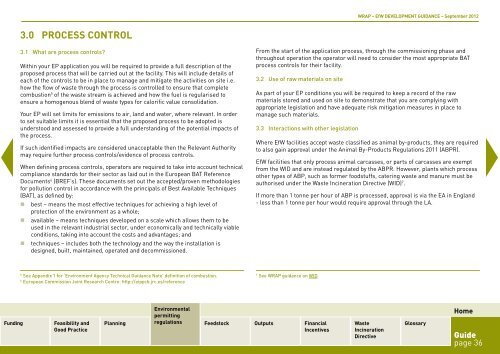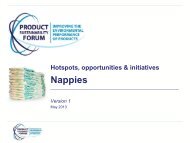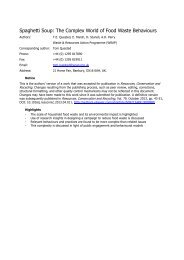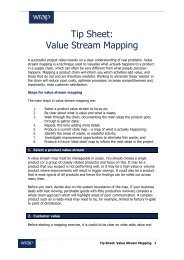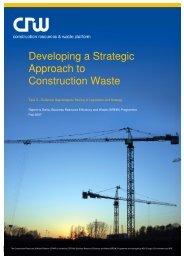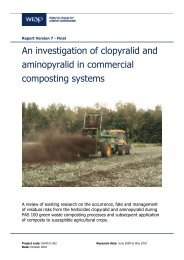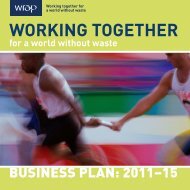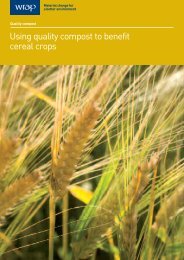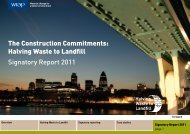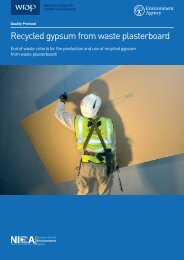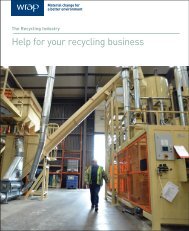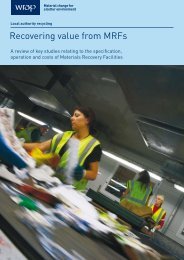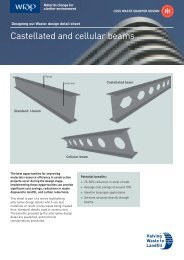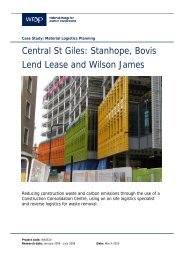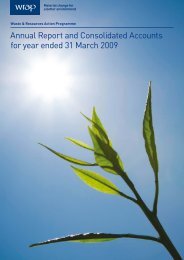EfW DEVELOPMENT GUIDANCE - Wrap
EfW DEVELOPMENT GUIDANCE - Wrap
EfW DEVELOPMENT GUIDANCE - Wrap
You also want an ePaper? Increase the reach of your titles
YUMPU automatically turns print PDFs into web optimized ePapers that Google loves.
WRAP – <strong>EfW</strong> <strong>DEVELOPMENT</strong> <strong>GUIDANCE</strong> – September 2012<br />
3.0 Process control<br />
3.1 What are process controls<br />
Within your EP application you will be required to provide a full description of the<br />
proposed process that will be carried out at the facility. This will include details of<br />
each of the controls to be in place to manage and mitigate the activities on site i.e.<br />
how the flow of waste through the process is controlled to ensure that complete<br />
combustion 5 of the waste stream is achieved and how the fuel is regularised to<br />
ensure a homogenous blend of waste types for calorific value consolidation.<br />
Your EP will set limits for emissions to air, land and water, where relevant. In order<br />
to set suitable limits it is essential that the proposed process to be adopted is<br />
understood and assessed to provide a full understanding of the potential impacts of<br />
the process.<br />
If such identified impacts are considered unacceptable then the Relevant Authority<br />
may require further process controls/evidence of process controls.<br />
When defining process controls, operators are required to take into account technical<br />
compliance standards for their sector as laid out in the European BAT Reference<br />
Documents 6 (BREF’s). These documents set out the accepted/proven methodologies<br />
for pollution control in accordance with the principals of Best Available Techniques<br />
(BAT), as defined by:<br />
• best – means the most effective techniques for achieving a high level of<br />
protection of the environment as a whole;<br />
• available – means techniques developed on a scale which allows them to be<br />
used in the relevant industrial sector, under economically and technically viable<br />
conditions, taking into account the costs and advantages; and<br />
• techniques – includes both the technology and the way the installation is<br />
designed, built, maintained, operated and decommissioned.<br />
From the start of the application process, through the commissioning phase and<br />
throughout operation the operator will need to consider the most appropriate BAT<br />
process controls for their facility.<br />
3.2 Use of raw materials on site<br />
As part of your EP conditions you will be required to keep a record of the raw<br />
materials stored and used on site to demonstrate that you are complying with<br />
appropriate legislation and have adequate risk mitigation measures in place to<br />
manage such materials.<br />
3.3 Interactions with other legislation<br />
Where <strong>EfW</strong> facilities accept waste classified as animal by-products, they are required<br />
to also gain approval under the Animal By-Products Regulations 2011 (ABPR).<br />
<strong>EfW</strong> facilities that only process animal carcasses, or parts of carcasses are exempt<br />
from the WID and are instead regulated by the ABPR. However, plants which process<br />
other types of ABP, such as former foodstuffs, catering waste and manure must be<br />
authorised under the Waste Incineration Directive (WID) 7 .<br />
If more than 1 tonne per hour of ABP is processed, approval is via the EA in England<br />
- less than 1 tonne per hour would require approval through the LA.<br />
5<br />
See Appendix 1 for ‘Environment Agency Technical Guidance Note’ definition of combustion.<br />
6<br />
European Commission Joint Research Centre: http://eippcb.jrc.es/reference<br />
7<br />
See WRAP guidance on WID.<br />
Funding<br />
Feasibility and<br />
Good Practice<br />
Environmental<br />
permitting<br />
Planning regulations Feedstock Outputs Financial<br />
Incentives<br />
Waste<br />
Incineration<br />
Directive<br />
Glossary<br />
Home<br />
Guide<br />
page 36


